Douglas TBD Devastator Video - Picture
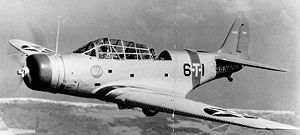
|
|
Douglas TBD Devastator
TBD Devastator

Picture - US Navy TBD-1 Torpedo Squadron Six (VT-6), USS Enterprise (CV-6), 1938
Role: Torpedo bomber
Manufacturer: Douglas Aircraft Company
First flight: 15 April 1935
Introduced: 3 August 1937
Retired: 1942 (from active service)
1944 (completely)
Primary user: United States Navy
Produced: 1937-1939
Number built: 130
The Douglas TBD Devastator was a torpedo bomber of the United States Navy, ordered in 1934, first flying in 1935 and entering service in 1937. At that point, it was the most advanced aircraft flying for the USN and possibly for any navy in the world. However, the fast pace of aircraft development caught up with it, and by the time of the Japanese attack on Pearl Harbor the TBD was already outdated. It performed well in some early battles, but in the Battle of Midway the Devastators launched against the Japanese fleet were almost totally wiped out. The type was immediately withdrawn from front line service, replaced by the Grumman TBF Avenger.
Design and development
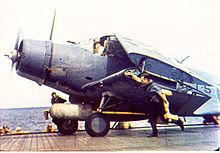
Picture - TBD from Torpedo Eight taxiing up the flight deck of Hornet circa 15 May 1942. This aircraft has been equipped with twin .30 in (7.62 mm) machine guns and is carrying a live torpedo.
Ordered on 30 June 1934, and entered into a U.S. Navy competition for new bomber aircraft to operate from its aircraft carriers, the Douglas entry was one of the winners of the competition. Other aircraft ordered for production as a result of the competition included the Northrop BT-1 which would evolve into the SBD Dauntless, the Brewster SBA and the Vought SB2U Vindicator.
The XTBD Devastator flying for the first time on 15 April 1935, marked a large number of "firsts" for the U.S. Navy.It was the first widely-used carrier-based monoplane as well as the first all-metal naval aircraft, the first with a totally-enclosed cockpit, the first with power-actuated (hydraulically) folding wings; it is fair to say that the TBD was revolutionary. A semi-retractable undercarriage was fitted, with the wheels designed to protrude 10 in (250 mm) below the wings to permit a "wheels-up" landing with only minimal damage. A crew of three was normally carried beneath a large "greenhouse" canopy almost half the length of the aircraft. The pilot sat up front; a rear gunner/radio operator took the rearmost seat, while the bombardier occupied the middle seat. During a bombing run, the bombardier lay prone, sliding into position under the pilot to sight through a window in the bottom of the fuselage, using the Norden Bombsight.
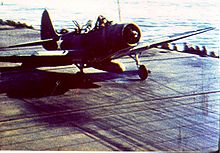
Picture - The last of Torpedo Eight's TBDs, T-16 (BuNo 1506), flown by LCDR John C. Waldron with Horace Franklin Dobbs, CRMP, in the rear seat, taking off from Hornet on 4 June 1942.
The normal TBD offensive armament consisted of either a 1,200 lb (540 kg) Bliss-Leavitt Mark 13 aerial torpedo or a 1,000 lb (450 kg) bomb. Alternately, three 500 lb (230 kg) general-purpose bombs: one under each wing and one under the fuselage, or 12 100 lb (45 kg) fragmentation bombs: six under each wing, could be carried. This weapons load was often used when attacking Japanese targets on the Gilbert and Marshall Islands in 1942.Defensive armament consisted of a .30 in (7.62 mm) machine gun for the rear gunner. Fitted in the starboard side of the cowling was either a .30 in (7.6 mm) or .50 in (12.7 mm) machine gun.
The powerplant was a Pratt & Whitney R-1830-64 Twin Wasp radial engine of 850 hp (630 kW), an outgrowth of the prototype's Pratt & Whitney XR-1830-60/R-1830-1 of 800 hp (600 kW).Other changes from the 1935 prototype included a revised engine cowling and raising the cockpit canopy to improve visibility.
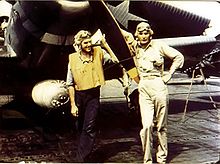
Picture - Ensign George Gay (right), sole survivor of Hornet's VT-8 squadron at Midway, standing in front of a TBD
The XTBD had a flat canopy that was replaced on production models by a higher, domed canopy over a roll over bar. Other than requests by test pilots to improve pilot visibility, the prototype easily passed its acceptance trials that took place from 24 April-24 November 1935 at NAS Anacostia and Norfolk bases. After successfully completing torpedo drop tests, the prototype was transferred to the Lexington for carrier certification. The extended service trials continued until 1937 with the first two production aircraft retained by the company exclusively for testing.
A total of 129 of the type were purchased by the U.S. Navy's Bureau of Aeronautics (BuAer), and starting from 1937, began to equip the carriers Saratoga, Enterprise, Lexington, Wasp, Hornet, Yorktown and Ranger. In pre-war use, TBD units were engaged in training and other operational activities and were gradually approaching the end of their useful service life with at least one aircraft being converted to target tug duty. By 1940, the U.S. Navy was aware that the TBD had become outclassed by the fighters and bombers of other nations and a replacement was in the works, but it was not yet in service when the U.S. entered World War II. By then, attrition had reduced their numbers to just over 100 aircraft. The U.S. Navy assigned popular names to its aircraft in late 1941, and the TBD became the Devastator, although its nickname "torpecker" was commonly used.
Operational history
In the early days of the Pacific war, the TBD acquitted itself well during February and March 1942 and in the Battle of the Coral Sea, in which Devastators helped sink the ShÅhÅ.
Problems were discovered with the Mark 13 torpedo at this point. Many were seen to hit the target yet fail to explode; there was also a tendency to run deeper than the set depth. It took over a year for the problems to be corrected. These problems were not fixed by the time of the Battle of Midway on 4 June 1942.
At Midway, a total of 41 Devastators, a majority of the type still operational, were launched from Hornet, Enterprise and Yorktown to attack the Japanese fleet. The sorties were not well coordinated, in part because Rear Admiral Raymond A. Spruance ordered a strike on the enemy carriers immediately after they were discovered, rather than spend the time to assemble a well-ordered attack among the different types of aircraft: fighters, bombers, torpedo planes, reasoning that attacking the Japanese would prevent a counterstrike against the US carriers. The TBDs lost contact with their fighter escort and started their attacks without fighter protection.
The Devastator proved to be a death trap for its crews: slow and scarcely maneuverable, with light defensive weaponry and poor armor relative to the weapons of the time; its speed on a glide-bombing approach was a mere 200 mph (320 km/h), making it easy prey for fighters and defensive guns alike. The aerial torpedo could not even be released at speeds above 115 mph (185 km/h).Torpedo delivery requires a long, straight-line attack run, making the aircraft vulnerable, and the slow speed of the aircraft made them easy targets for the Mitsubishi A6M Zeros. Only four TBDs made it back to Enterprise, none to Hornet and two to Yorktown, without scoring a torpedo hit.
Nonetheless, their sacrifice was not completely in vain, as several TBDs managed to get within a few ship-lengths range of their targets before dropping their torpedoes, being close enough to be able to strafe the enemy ships and force the Japanese carriers to make sharp evasive maneuvers. As the carriers were in the midst of refueling and rearming operations with planes on the deck ready to take off, they were unable to launch these armed and fueled planes due to the TBD attacks, so this left the carriers in an even more vulnerable position. Furthermore, the heroic actions of the Devastator aircrews that day drew the Japanese air cover out of position. This window of opportunity was exploited by the late-arriving Douglas SBD Dauntless dive bombers led by Lieutenant Commander C. Wade McClusky and Max Leslie, and three of the four Japanese carriers were fatally damaged shortly afterwards.
The Navy immediately withdrew the TBD from front-line units after Midway; in any case, there were only 39 aircraft left. They remained in service briefly in the Atlantic and in training squadrons until 1944. The original prototype finished its career at NAS Norman, Oklahoma, and the last TBD in the U.S. Navy was used by the Commander of Fleet Air Activities-West Coast. When his TBD was scrapped in November 1944, there were no more. None survived the war and there are none known to exist on dry land today.
In fairness to the Devastator, the newer TBF Avengers were similarly ineffective, losing five out of six aircraft without scoring a hit at Midway. The Avengers' only successes in 1942 would be against the light carrier RyūjŠand the battleship Hiei In the initial part of the Pacific War, the poor performances of US torpedo bombers was due to the vulnerability of that type in general against AAA fire and defending fighters, plus the inexperience of American pilots and lack of coordinated fighter cover. It took growing American air superiority, improved attack coordination, and more experienced pilots, before the Avengers were able to successfully accomplish their roles in subsequent battles against Japanese surface forces.
After the debacle at Midway, the surviving TBD Devastators in VT-4 and VT-7 remained in service for a short time before being shipped back to the United States where the aircraft were relegated to training duties for pilots and mechanics or were destroyed following use as instructional airframes for fire-fighting training. By late 1944, no TBD Devastators were left in the US Navy inventory.
Variants
XTBD-1
Prototype powered by a 800 hp (600 kW) XR-1830-60, one built.
TBD-1
Production variant powered by a 850 hp (630 kW) R-1830-64, 129 built.
TBD-1A
One TBD-1 modified with twin floats.
Operators

Picture - VT-4 TBD-1 taking off from Ranger in 1942
United States
United States Navy
VT-2 used 58 Devastators between December 1937 and May 1942.
VT-3 used 71 Devastators between October 1937 and June 1942. They starred in the 1941 movie Dive Bomber.
VT-4 used 9 Devastators between December 1941 and September 1942.
VT-5 used 57 Devastators between February 1938 and June 1942.
VT-6 used 62 Devastators between April 1938 and June 1942.
VT-7 used 5 Devastators between January 1942 and July 1942.
VT-8 used 23 Devastators between September 1941 and June 1942.
VB-4 used 3 Devastators between December 1941 and January 1942.
VS-42 used 3 Devastators between December 1940 and December 1941.
VS-71 used 8 Devastators between December 1940 and June 1942.
VS-72 used 2 Devastators in June 1941.
VU-3 used a single Devastator from January till May 1940.
United States Marine Corps
VMS-2 used a single Devastator, BuNo. 1518, from 26 March 1941 till 5 June 1941, loaned from VT-3.
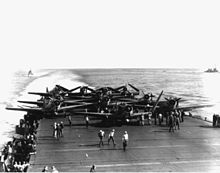
Picture - VT-6 TBDs on Enterprise, during the Battle of Midway
Survivors
There are no Devastators in any collection or museum. Several wrecks are known and are being investigated for possible salvage and restoration:
TBD-1, BuNo.0298 Ex-VT-5 / USS Yorktown (CV-5) "5-T-7", Jaluit Lagoon, Marshall Islands. TBD-1 BuNo.0353 Ex-NAS Miami, Atlantic Ocean, Miami, Florida. TBD-1 BuNo.1515 Ex VT-5 / USS Yorktown (CV-5) "5-T-6", Jaluit Lagoon, Marshall Islands.
Specifications (TBD-1)
General characteristics
Crew: Three: Pilot, Torpedo Officer/Navigator, Radioman/Gunner
Length: 35 ft (10.67 m)
Wingspan: 50 ft (15.24 m)
Height: 15 ft 1 in (4.60 m)
Wing area: 422 ft² (39.2 m²)
Empty weight: 6,182 lb (2,804 kg)
Loaded weight: 9,862 lb (4,473 kg)
Max takeoff weight: 10,194 lb (4,623 kg)
Powerplant: 1x Pratt & Whitney R-1830-64 Twin Wasp radial engine, 850 hp (634 kW)
Performance
Maximum speed: 206 mph (331 km/h)
Range: 435 mi (700 km) with Mk XIII Torpedo, 716 mi (1,152 km) with 1,000 lb (454 kg) bombs ()
Service ceiling: 19,700 ft (6,000 m)
Rate of climb: 720 ft/min (3.7 m/s)
Armament
Guns: 1 x forward-firing 0.30 in (7.62 mm) or 0.50 (12.7 mm) machine gun
1 x 0.30 in (7.62 mm) machine gun in rear cockpit (later increased to two)
Bombs: 1 x 1,000 lb (454 kg) bomb
1 x Mark XIII torpedo - 1,200 lb (544 kg) 3 x 500 lb (227 kg) bombs 12 x 100 lb (45 kg) bombs
Notable appearance in media
Dive Bomber (1941) was a American propaganda film directed by Michael Curtiz. It is notable for both its Technicolor photography of pre-World War II United States Navy aircraft featuring the TBD Devastator, and scenes on the aircraft carrier Enterprise as well as the NAS North Island in San Diego.
Comparable aircraft
Fairey Barracuda
Great Lakes XTBG
Grumman TBF Avenger
Nakajima B5N
Nakajima B6N
Yokosuka B4Y
Citations
Bibliography
Adcock, Al. TBD Devastator in Action, Aircraft Number 97. Carrollton, TX: Squadron/Signal Publications Inc., 1989. ISBN 0-89747-231-4.
Buell, Thomas B. The Quiet Warrior: A Biography of Admiral Raymond A. Spruance. Annapolis, MD: US Naval Institute Press, 1987. ISBN 978-0870215629.
Cressman, Robert B. et al. A Glorious Page in Our History: The Battle of Midway, 4-6 June 1942. Missoula, MT: Pictorial Histories Publishing Company, 1990. ISBN 978-0929521404.
Dolan, Edward F. Jr. Hollywood Goes to War. London: Bison Books, 1985. ISBN 0-86124-229-7.
Doll, Thomas E. The Douglas TBD Devastator, Aircraft in Profile Number 171. Leatherhead, Surrey, UK: Profile Publications Ltd., 1967. No ISBN.
Doll, Thomas E. SB2U Vindicator in action, Aircraft Number 122. Carrollton, TX: Squadron/Signal Publications Inc., 1992. ISBN 0-89747-247-8
Drendel, Lou. U.S. Navy Carrier Bombers of World War II. Carrollton, TX: Squadron/Signal Publications Inc., 1987. ISBN 0-89747-195-4.
Ginter, Steve. Douglas TBD-1 Devastator, Naval Fighters Number Seventy-one. Simi Valley, California: Ginter Publishing Company, 2006. ISBN 0-942612-71-X.
Gunston, Bill. The Encyclopedia of the World's Combat Aircraft: A Technical Directory of Major Warplanes from World War 1 to the Present Day. New York: Chartwell Books, Inc., 1976. ISBN 0-89009-058-8.
Hardwick, Jack and Ed Schnepf. "A Viewer's Guide to Aviation Movies". The Making of the Great Aviation Films, General Aviation Series, Volume 2, 1989.
Jackson, B.R. and Thomas E. Doll. Douglas TBD-1 "Devastator", Aero Series 23. Fallbrook, CA: Aero Publishers, 1973. ISBN 0-8168-0586-5.
Kinzey, Bert. U.S. Navy and Marine Aircraft of World War II, Part 1: Dive and Torpedo Bombers. Northbrook, Illinois: Revell-Monogram, LLC, 2003. ISBN 0-99709900-6-7.
Lawson, Robert and Barrett Tillman. U.S. Navy Dive and Torpedo Bombers of WWII. St. Paul, MN: MBI Publishing Company, 2001. ISBN 0-7603-0959-0.
Mondey, David. "Douglas TBD Devastator." The Hamlyn Concise Guide to American Aircraft of World War II. London: Bounty Books, 2006. ISBN 0-753714-60-4.
Nowicki, Jacek. Douglas TBD Devastator - SBD Dauntless (Wydawnictwo Militaria 119) (in Polish). Warszawa, Poland: Wydawnictwo Militaria, 2000. ISBN 83-7219-074-7.
Orriss, Bruce. When Hollywood Ruled the Skies: The Aviation Film Classics of World War II. Hawthorne, California: Aero Associates Inc., 1984. ISBN 0-9613088-0-X.
Parshall, Jonathan B. and Anthony P. Tully. Shattered Sword: The Untold Story of the Battle of Midway. Washington, DC: Potomac Books, 2005. ISBN 1-57488-923-0.
Taylor, John W.R. "Douglas TBD Devastator". Combat Aircraft of the World from 1909 to the Present. New York: G.P. Putnam's Sons, 1969. ISBN 0-425-03633-2.
Tillman, Barrett. "Go in and get a hit!: The Navy's last combat torpedo bombers." Airpower, Volume 3, No. 4, July 1973.
Tillman, Barrett. TBD Devastator Units of the U.S. Navy, Combat Aircraft Vol. 20. Oxford, UK: Osprey Publishing, 2000. ISBN 1-841760-25-0.
Tillman, Barrett and Robert L. Lawson. U.S. Navy Dive and Torpedo Bombers of WWII. St. Paul, Minnesota: MBI Publishing Company, 2001. ISBN 0-7603-0959-0.
Winchester, Jim. "Douglas TBD Devastator." Aircraft of World War II (The Aviation Factfile). Kent, UK: Grange Books plc, 2004. ISBN 1-84013-639-1.)
Douglas TBD Devastator Pictures
More aircraft.
Source: WikiPedia